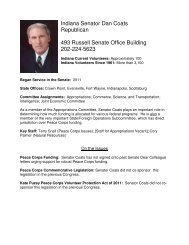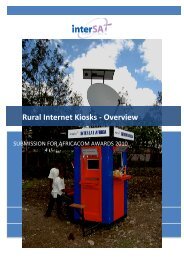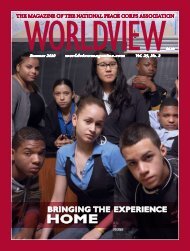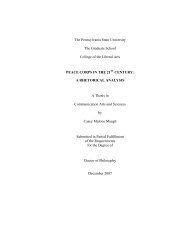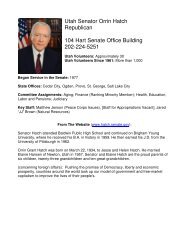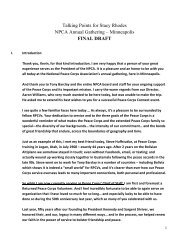Group Education Manual - Peace Corps Wiki
Group Education Manual - Peace Corps Wiki
Group Education Manual - Peace Corps Wiki
Create successful ePaper yourself
Turn your PDF publications into a flip-book with our unique Google optimized e-Paper software.
11.3ObjectivesTimeMedia Campaigns and Social Marketing1. To understand the principles of social marketing and practice the steps fordeveloping a community-based or mass media campaign.Two hoursMaterials • Flipchart paper and markers• Enough copies of Handout 17: Media Campaigns and Social Marketing and•Handout 18: Creating Campaigns: Step By Step for all participantsResource Sheet13: Examples of Social-Marketing Media and Community-Facilitator’sNotesBased CampaignsCampaigns are coordinated sets of activities that aim to promotechanges in individual behaviors and/or promote the socio-cultural and political normsnecessary to support these changes. Campaigns often include some form of mediaand target large numbers of people.Community-based media, such as street theatre, often provides more depth andinteraction, whereas mass media may offer less depth and interaction, but oftenprovides wider reach of messages. The decision to use community-based or massmedia, or a combination of both types, will depend on available resources, theintended audience, and depth of contact expected.PART 1: Principles of Campaigns (30 minutes)1. Ask the participants to brainstorm examples of good TV/radio commercialsand/or print advertisements.2. Ask the participants to identify the messages or strategies thatmade those commercials and advertisements successful.3. Explain to the participants that public health campaigns areincreasingly using principles from commercial marketing to successfully“sell” healthy behaviors and lifestyles. Review Handout 17: Media Campaigns andSocial Marketing with the participants and ask them for examples of social marketingcampaigns they have seen, if those campaigns were successful, and why. Askparticipants to volunteer a definition for social marketing, BCC (Behavior ChangeCommunication), and IEC (Information, <strong>Education</strong> and Communication).4. Explain to the participants that behavior and lifestyle is often influenced bypeople’s perceptions of what is “normal” or “typical,” that is, what they believe mostof their peers do. However, many individuals often misperceive the typical behaviorsor attitudes of their peers. For example, young men may believe that a majority oftheir peers engage in certain risk behaviors, such as excessive drinking, when in mostsettings, the majority of young men do not.5. Use the following questions to engage the participants in adiscussion about how social norms and the media influence young men’s behaviorsand lifestyles:? Does the media influence our behavior? How?? What are some misperceptions or rigid ideas that men and others(partners, families, etc.) may have about typical behaviors of men? Doesthe media perpetuate these misperceptions? How?? What kind of behaviors can these misperceptions spur?96



